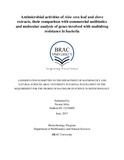| dc.contributor.advisor | Hossain, Dr. M. Mahboob | |
| dc.contributor.author | Afrin, Nusrat | |
| dc.date.accessioned | 2018-02-14T09:02:36Z | |
| dc.date.available | 2018-02-14T09:02:36Z | |
| dc.date.copyright | 2017 | |
| dc.date.issued | 2017-06 | |
| dc.identifier.other | ID 12236005 | |
| dc.identifier.uri | http://hdl.handle.net/10361/9464 | |
| dc.description | This thesis is submitted in partial fulfillment of the requirements for the degree of Bachelor of Science in Biotechnology, 2017. | en_US |
| dc.description | Cataloged from PDF version of thesis report. | |
| dc.description | Includes bibliographical references (pages viii-xviii). | |
| dc.description.abstract | The need for new, potent antimicrobial agents from natural sources is increasing because of the growing cases of multidrug resistance in clinically relevant organisms. The purpose of this study was to investigate in vitro antimicrobial activity of Aloe vera leaf and clove extracts against microorganisms isolated from clinical samples. The antibacterial activities were then compared to commercial antibiotics, and the samples resistant to most antibiotics were screened for two multidrug resistant genes (blaNDM-1 and blaOXA-2). Antimicrobial susceptibility testing of a total of 21 clinical isolates (10 Pseudomonas, 10 Klebsiella and 1 E.coli) were carried out using crude ethanol, methanol, acetone and aqueous extracts of Aloe vera leaf and clove. Kirby-Bauer disk diffusion test of the same organisms was done using the following antibiotics: imipenem, meropenem, gentamicin, oxacillin, cloxacillin, ceftazidime, ampicillin, amikacin, kanamycin and ciprofloxacin. Strains highly resistant to most of the beta-lactam antibiotics were then screened for New Delhi metallo-beta-lactamase-1 (NDM-1) and OXA-2 genes using PCR. Extracts of both Aloe vera leaf and clove were effective against all the isolates, with the highest activity exhibited by acetone extracts. Aqueous plant extracts showed little to no activity against the isolates, except for three Pseudomonas samples whose growths were inhibited by aqueous clove extracts. All the bacterial isolates were highly resistant to most of the antibiotics except imipenem, meropenem and ciprofloxacin. It was also observed that 100% of the organisms were resistant to oxacillin, cloxacillin and ampicillin. While some samples were highly susceptible to some antibiotics, others showed little and moderate susceptibility. However, PCR with specific primers and gel electrophoresis revealed that none of the bacterial strains carried blaNDM-1 or blaOXA-2 genes. | en_US |
| dc.description.statementofresponsibility | Nusrat Afrin | |
| dc.format.extent | 62 pages | |
| dc.language.iso | en | en_US |
| dc.publisher | BRAC University | en_US |
| dc.rights | BRAC University thesis reports are protected by copyright. They may be viewed from this source for any purpose, but reproduction or distribution in any format is prohibited without written permission. | |
| dc.subject | Aloe vera | en_US |
| dc.subject | Clove extract | en_US |
| dc.subject | Antibiotics | en_US |
| dc.subject | Bacteria | en_US |
| dc.title | Antimicrobial activities of Aloe vera leaf and clove extracts, their comparison with commercial antibiotics and molecular analysis of genes involved with multidrug resistance in bacteria | en_US |
| dc.type | Thesis | en_US |
| dc.contributor.department | Department of Mathematics and Natural Sciences, BRAC University | |
| dc.description.degree | B. Biotechnology
| |

